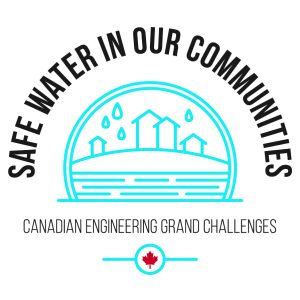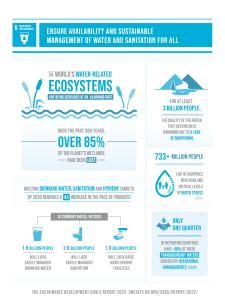CEGC 3: Access to Safe Water in All Communities

Connection to the United Nations Sustainable Development Goals
| Ready access to clean and affordable water allows for decreased financial burden on low-income populations | Affordable and safe water provides a service that is equally valuable to both low and high-income populations | ||
| Safe water is vitally important to the health of the public | Safely and sustainably treating water and wastewater can reduce anthropogenic environmental impacts | ||
| The availability and sustainable management of water and sanitation provides safe water in our communities | Water and the climate are closely related, with each depending on the other | ||
| Clean water is critical to many successful industries and public infrastructure |
What is the Canadian Engineering Grand Challenge Statement?
The challenge for safe water in our communities is to protect water sources and to ensure safe water delivery within complex water cycles and systems (EDC-DDIC, 2022).
High Level Overview of the Canadian Engineering Grand Challenge
Water is an essential nutrient for life across the planet, and access to clean water is described by the United Nations as a basic human right. Not just for drinking, water is used in cooking, agriculture, sanitation, and much more. This water supply, while valuable, is not a guarantee. Despite Canada’s relative abundance of freshwater, many areas in Canada have their water supply threatened by climate change-exacerbated issues such as flooding, water scarcity, wildfires, and invasive biological contaminants. Alongside these challenges, the aging of water treatment and distribution infrastructure is a continuous issue. There is also a current lack of equity in clean water provision across Canada. Despite progress, there are still many long-term drinking water advisories that have been in place for years on First Nations reservations. In order to provide for a future of abundant and available water, engineers of today must be prepared to make informed decisions that will protect Canadian water for years to come.
Example Connection to a Sustainable Development Goal
CEGC 3: Access to Safe Water in All Communities maps to several Sustainable Development Goals, where an example of one of the connections is to SDG 6 – Clean Water and Sanitation, which has a goal to “Ensure availability and sustainable management of water and sanitation for all” (United Nations, 2023).
Figure: Infographic on Sustainable Development Goal 6 (United Nations, 2023)
Keywords: watershed, source water protection, transboundary water movement, temporal variability, spatial variability, contaminant
Status of the Challenge Globally
Water security throughout the world is at risk. Globally, roughly 25% of people lack access to clean water at home (Global Wash Fast Facts, 2022). While that means that 75% of people do have access to clean water, this is unacceptable as water is a basic human right. Issues such as aging infrastructure and climate change threaten existing systems, and new contaminants are continuously being produced by industries.
Status of the Challenge in Canada
Aging Infrastructure and Climate Change
Water and wastewater infrastructure requires maintenance and replacement over time if it is going to continue to provide service to the residents it serves. Aging infrastructure is making it more and more difficult to deliver clean water to small communities across Canada. Old watermains are more likely to burst, where North America has seen a 27% increase in pipe breakages as 28% of the mains are over 50 years old (EDC-DDIC, 2022). Pipe breakages not only interrupt water service, but they also waste water and increase the likelihood of contaminants entering the water system. With middling to small sized communities shrinking across Canada as urbanization increases, funding for water programs that could replace these old lines decreases as the tax base moves elsewhere. Additionally, the changing climate brings a host of new challenges to the drinking water industry. Water scarcity is a rising issue as humans consume more and more water for residential and industrial uses. On the other hand, the changing climate is leading to aggressive rainfall in some areas that can lead to flooding and associated contamination of freshwater sources. Invasive biological contaminants such as toxic algal blooms are becoming more common than ever as waters warm. Furthermore, new chemical contaminants and microplastics are constantly being introduced into water sources from industry waste and everyday products.
Drinking Water Advisories
Access to clean water is a human right. Despite this, there are many communities in Canada that do not have reliable access to safe drinking water. First Nations’ communities in particular see a lack of equitable distribution of drinking water. As of July 2022, 34 long-term drinking water advisories remain on reserves, and have been in place for more than 25 years (Safe Water for First Nations, 2022). Drinking water advisories mean that water is unsafe to consume as it is delivered, forcing residents to boil water before consuming it or even possibly preventing them from using it at all. Current ways of circumventing this issue are time consuming and expensive, such as having water delivered by truck or hauling water back from a filling station. There is also a large funding deficit for the maintenance and operation of drinking water systems on First Nations’ reserves, estimated at $138 million per year (Safe Water for First Nations, 2022).
Roadblocks to Success
Delivering safe water to communities across all of Canada is both an important and a difficult task. Large amounts of public funding are required in order to construct quality water infrastructure, and it can be challenging to increase revenue generation to match costs. Water is provided to many Canadian communities at a low cost; however, the public resists change that would increase price of water. With roughly 30% of Canadian water infrastructure in fair, poor, or very poor condition, replacements and upgrades will soon be needed (Canadian Infrastructure Report Card, 2019). Aside from funding generation, it can be difficult for communities to determine how to best spend the money that they have. Improved information gathering on water systems is necessary to improve decision making. This can come in the form of remote sensing or regular surveys of water networks. New and emerging contaminants in water systems are another source of concern and obstacle in the way of delivering clean water. Knowledge of which of these contaminants are not handled by the current treatment system and are major issues is an ongoing process. Finally, planning for an uncertain future brought about by climate change is a difficult process. Water infrastructure is expected to last for decades, which means unknown future climate factors must be taken into account as much as possible in planning.
Strategies to Meet 2030 Targets
To address the challenge of supplying safe water to all communities, Engineering Deans Canada have identified the following strategies (CEGC Document, 2022):
- Refining strategies to respond and protect against climate change impacts on our ability to deliver safe water
- Decreasing vulnerabilities regarding provision of safe water to all communities, which will benefit greatly from improved data collection and management, including sensor technologies and remote monitoring.
- Integrating data for improved decision-making by proactively adopting AI and remote monitoring, in addition to eliminating technological impediments to innovation in the water sector.
- Adopting a proactive approach to ensure the health and safety for all, and identifying system vulnerabilities to provide guidance on how water systems may fail.
- Empowering small urban and Indigenous communities to the needed information and budgets to improve the management of their systems and expand the learning and education of operators.
- Transitioning to adaptive water treatment technologies which has the ability to transform the water industry, but the industry must be allowed to adapt accordingly.
- Developing source water protection plans to provide a basis for protection of the integrity of water supply systems.
References
- EDC-DDIC. (2022, May 6). Canadian Engineering Grand Challenges (2020-2030). Engineering Deans Canada. Retrieved February 23, 2023, from https://engineeringdeans.ca/en/canadian-engineering-grand-challenges-2020-2030-inspiring-action-to-improve-life-for-canadians-and-the-world/
- United Nations (2023). The 17 Goals, United Nations Department of Economic and Social Affairs, Sustainable Development. Retrieved February 27, 2023, from https://sdgs.un.org/goals


